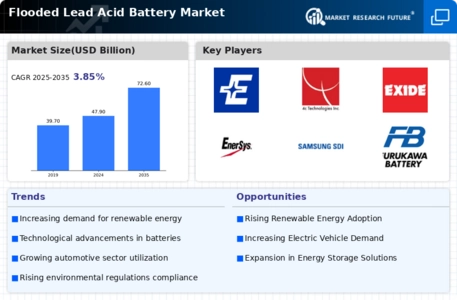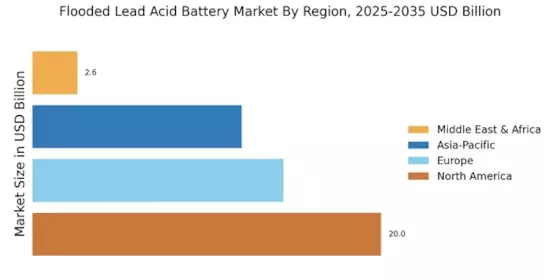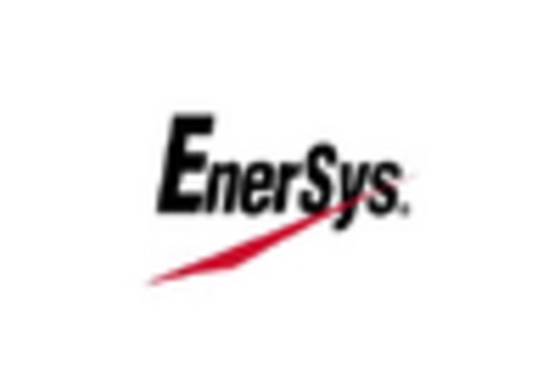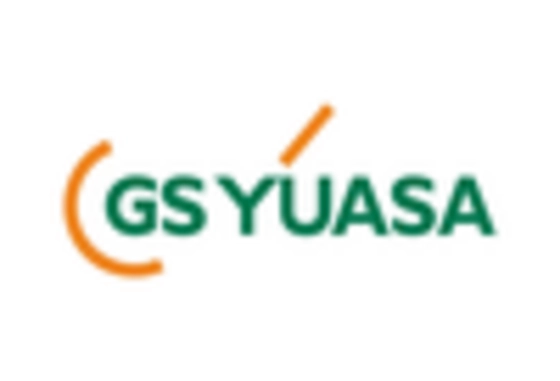Increased Use in Automotive Applications
The automotive sector is witnessing a resurgence in the use of flooded lead acid batteries, particularly in traditional internal combustion engine vehicles. The Flooded Lead Acid Battery Market is benefiting from this trend, as these batteries are favored for their reliability and performance in starting, lighting, and ignition applications. In 2025, the automotive industry is expected to maintain a steady demand for flooded lead acid batteries, especially in regions where electric vehicle adoption is slower. This sustained demand is indicative of the battery's established role in the automotive sector, providing a stable market for manufacturers. Additionally, the compatibility of flooded lead acid batteries with various vehicle types further solidifies their relevance in the automotive landscape.
Rising Demand for Renewable Energy Storage
The increasing emphasis on renewable energy sources, such as solar and wind, is driving the need for efficient energy storage solutions. Flooded Lead Acid Battery Market is poised to benefit from this trend, as these batteries are often utilized in off-grid renewable energy systems. The ability to store energy generated during peak production times for later use is crucial for the stability of renewable energy systems. In 2025, the demand for energy storage is projected to grow significantly, with flooded lead acid batteries playing a vital role in balancing supply and demand. This trend indicates a robust market potential for flooded lead acid batteries, as they provide a cost-effective solution for energy storage, particularly in residential and commercial applications.
Regulatory Support for Energy Storage Solutions
Government policies and regulations increasingly favor energy storage solutions, which is advantageous for the Flooded Lead Acid Battery Market. Incentives and subsidies for renewable energy projects often include provisions for energy storage, thereby promoting the use of flooded lead acid batteries. In 2025, various regions are expected to implement supportive regulations that encourage the integration of energy storage systems into the grid. This regulatory environment is likely to enhance the market appeal of flooded lead acid batteries, as they align with sustainability goals and energy efficiency initiatives. The potential for financial incentives may further stimulate demand, positioning flooded lead acid batteries as a viable option for energy storage in both residential and commercial applications.
Technological Innovations Enhancing Performance
Technological advancements in battery design and manufacturing are contributing to the evolution of the Flooded Lead Acid Battery Market. Innovations aimed at improving the efficiency, lifespan, and performance of flooded lead acid batteries are emerging, making them more competitive against newer technologies. In 2025, ongoing research and development efforts are expected to yield enhancements that could increase the energy density and reduce maintenance requirements of these batteries. Such improvements may lead to a resurgence in interest from sectors that have previously shifted towards alternative battery technologies. The potential for enhanced performance could revitalize the market, ensuring that flooded lead acid batteries remain a relevant choice for energy storage solutions.
Cost-Effectiveness of Flooded Lead Acid Batteries
Cost considerations remain a primary driver in the Flooded Lead Acid Battery Market. These batteries are generally more affordable compared to alternative technologies, such as lithium-ion batteries. The lower initial investment makes them an attractive option for various applications, including automotive, industrial, and renewable energy storage. As of 2025, the average price of flooded lead acid batteries continues to be competitive, which encourages widespread adoption across different sectors. This cost-effectiveness is particularly appealing to budget-conscious consumers and businesses, thereby sustaining demand in the market. Furthermore, the long lifecycle and recyclability of these batteries enhance their economic viability, reinforcing their position in the energy storage landscape.


















Leave a Comment